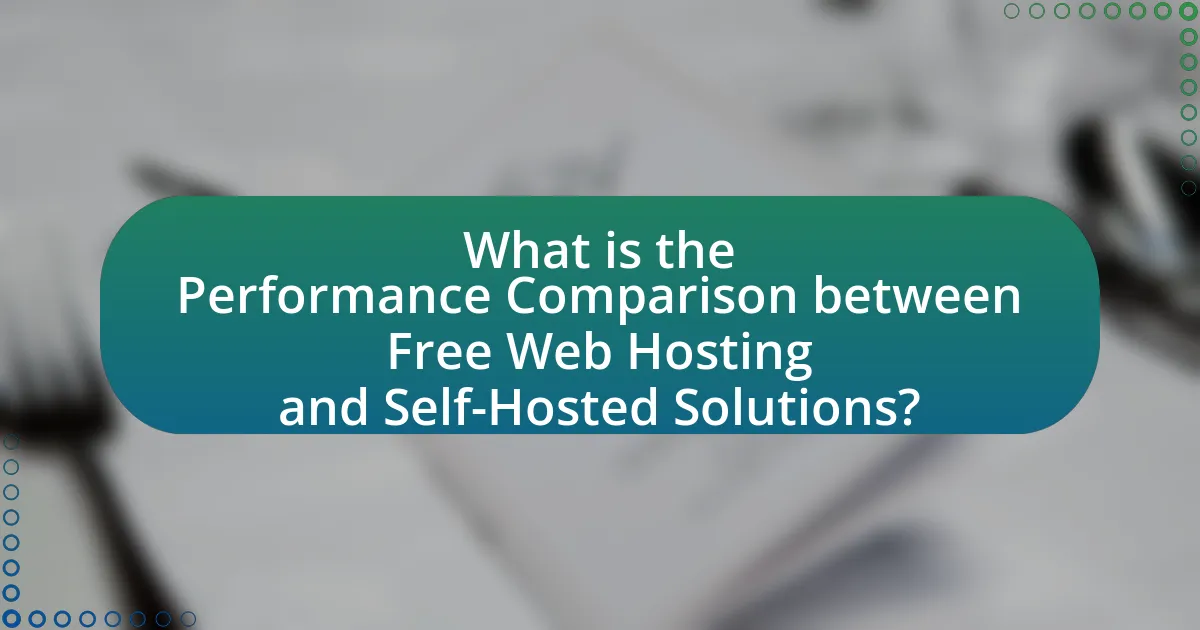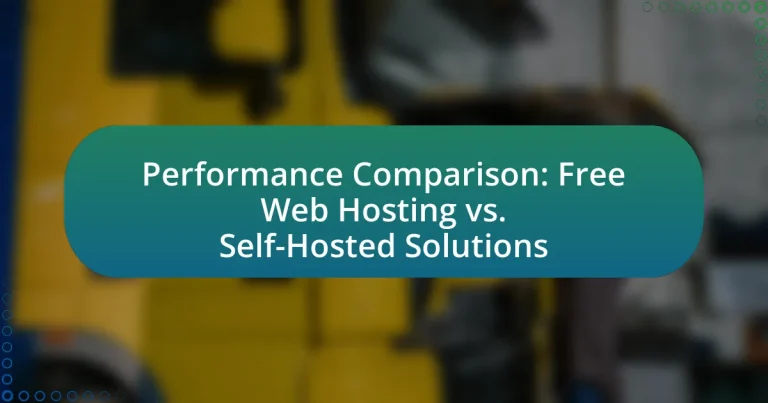The article provides a detailed performance comparison between free web hosting and self-hosted solutions, highlighting the significant differences in resource allocation, speed, and reliability. It outlines how free web hosting often suffers from limited resources, resulting in slower load times and higher downtime, while self-hosted solutions offer dedicated resources that enhance performance and user experience. Key factors influencing performance for both hosting types are examined, including server specifications, bandwidth, and maintenance requirements. Additionally, the article discusses the advantages and disadvantages of each option, emphasizing the importance of performance in user experience and search engine rankings.

What is the Performance Comparison between Free Web Hosting and Self-Hosted Solutions?
Free web hosting typically offers lower performance compared to self-hosted solutions. Free hosting often comes with limited resources, such as bandwidth and storage, which can lead to slower load times and reduced reliability. For instance, many free hosting services impose restrictions on server performance and may experience higher downtime due to shared resources among multiple users. In contrast, self-hosted solutions allow for dedicated resources, enabling faster response times and better overall performance. Studies indicate that websites on self-hosted platforms can load up to 50% faster than those on free hosting services, enhancing user experience and SEO rankings.
How do Free Web Hosting and Self-Hosted Solutions differ in terms of performance?
Free web hosting typically offers lower performance compared to self-hosted solutions due to limited resources, bandwidth restrictions, and shared server environments. In free hosting, multiple users share the same server, which can lead to slower load times and reduced reliability during peak traffic. In contrast, self-hosted solutions provide dedicated resources, allowing for optimized performance, faster loading speeds, and greater control over server configurations. Studies indicate that websites on self-hosted platforms can achieve load times under two seconds, while free hosting services often exceed this benchmark, resulting in a subpar user experience.
What factors influence the performance of Free Web Hosting?
The performance of free web hosting is influenced by several key factors, including server resources, bandwidth limitations, uptime reliability, and customer support. Server resources, such as CPU and RAM, directly affect the speed and responsiveness of hosted websites; limited resources can lead to slower load times. Bandwidth limitations restrict the amount of data that can be transferred, impacting site performance during high traffic periods. Uptime reliability is crucial, as frequent downtimes can lead to loss of visitors and credibility; many free hosting services offer lower uptime guarantees compared to paid options. Lastly, customer support availability can affect how quickly issues are resolved, influencing overall user experience and site performance.
What factors influence the performance of Self-Hosted Solutions?
The performance of self-hosted solutions is influenced by several key factors, including server hardware specifications, network bandwidth, software optimization, and system configuration. Server hardware specifications, such as CPU speed, RAM capacity, and storage type (SSD vs. HDD), directly affect processing power and data retrieval speeds. Network bandwidth determines the amount of data that can be transmitted simultaneously, impacting load times and user experience. Software optimization, including the efficiency of the code and the use of caching mechanisms, plays a crucial role in resource management and response times. Lastly, system configuration, which encompasses settings related to the operating system, database management, and application deployment, can significantly enhance or hinder overall performance.
Why is performance an important consideration for web hosting?
Performance is an important consideration for web hosting because it directly impacts website speed, user experience, and search engine rankings. A high-performance hosting service ensures faster loading times, which can lead to lower bounce rates; studies show that a one-second delay in page load time can reduce conversions by 7%. Additionally, search engines like Google prioritize fast-loading websites in their rankings, making performance crucial for visibility. Therefore, selecting a hosting solution that prioritizes performance can significantly enhance both user engagement and overall site effectiveness.
How does performance impact user experience?
Performance directly impacts user experience by influencing load times, responsiveness, and overall satisfaction with a website or application. Faster performance leads to reduced wait times, which enhances user engagement; studies show that a one-second delay in page load time can lead to a 7% reduction in conversions. Additionally, high-performance systems provide smoother interactions, which can increase user retention. For instance, Google found that as page load time increases from one second to ten seconds, the probability of a mobile site visitor bouncing increases by 123%. Thus, performance is a critical factor in shaping user experience and driving user behavior.
What are the consequences of poor performance in web hosting?
Poor performance in web hosting leads to significant negative impacts on website functionality and user experience. Slow loading times can result in higher bounce rates, with studies indicating that a one-second delay can decrease customer satisfaction by 16% and reduce conversions by 7%. Additionally, unreliable uptime can cause loss of traffic and revenue, as websites that experience frequent downtime can lose up to 40% of their visitors. Furthermore, poor performance can harm search engine rankings, as Google considers site speed a ranking factor, potentially leading to decreased visibility and organic traffic. Overall, the consequences of poor web hosting performance can severely affect a business’s online presence and profitability.

What are the advantages and disadvantages of Free Web Hosting?
Free web hosting offers several advantages and disadvantages. The primary advantage is cost savings, as it allows users to create and maintain a website without financial investment, making it accessible for individuals and small businesses. Additionally, free web hosting often includes user-friendly interfaces and basic features that simplify website creation for beginners.
However, the disadvantages include limited resources, such as bandwidth and storage, which can hinder website performance and scalability. Free hosting services frequently display advertisements on users’ sites, which can detract from the user experience and brand image. Furthermore, these services often lack customer support and security features, increasing vulnerability to cyber threats. According to a 2022 survey by HostingAdvice, 70% of users reported dissatisfaction with the reliability and performance of free hosting services, highlighting the trade-offs involved.
What benefits does Free Web Hosting provide?
Free web hosting provides cost savings, allowing users to create and maintain websites without financial investment. This benefit is particularly advantageous for individuals, startups, or small businesses with limited budgets. Additionally, free web hosting often includes user-friendly interfaces and basic tools that simplify website creation and management, making it accessible for those with minimal technical skills. According to a survey by HostingAdvice, 70% of new website owners prefer free hosting options to test their ideas before committing to paid services, highlighting the practicality of free web hosting for initial online presence.
How does cost-effectiveness play a role in choosing Free Web Hosting?
Cost-effectiveness is a primary factor in choosing free web hosting, as it allows users to establish an online presence without incurring financial costs. Many individuals and small businesses opt for free web hosting to minimize expenses, especially when they have limited budgets or are just starting. According to a survey by HostingAdvice, 70% of small businesses reported that cost was a significant factor in their hosting decisions. Free web hosting provides essential features, such as basic storage and bandwidth, which can be sufficient for personal projects or small websites, making it an attractive option for those prioritizing budget constraints.
What features are typically included in Free Web Hosting services?
Free web hosting services typically include features such as limited storage space, bandwidth, and support for basic website building tools. These services often provide a subdomain instead of a custom domain, and may include advertisements on hosted sites. Additionally, free web hosting usually offers limited customer support and lacks advanced features like SSL certificates or database access. According to a survey by HostingAdvice, 70% of free hosting providers impose restrictions on storage and bandwidth, confirming the common limitations associated with these services.
What limitations should users be aware of with Free Web Hosting?
Free web hosting typically comes with several limitations that users should be aware of, including restricted bandwidth, limited storage space, and lack of customer support. These constraints can hinder website performance and scalability, as many free hosting services impose strict data transfer limits, which can lead to slow loading times or downtime during high traffic periods. Additionally, users often face limitations on the types of applications they can run and may not have access to essential features like custom domain names or email accounts. Furthermore, free hosting providers frequently display advertisements on users’ websites, which can detract from the user experience and brand image.
How does resource allocation affect Free Web Hosting performance?
Resource allocation significantly impacts Free Web Hosting performance by determining the availability of essential resources such as bandwidth, storage, and processing power. Limited resource allocation often leads to slower website loading times, increased downtime, and reduced overall reliability, as multiple users share the same server resources. For instance, a study by HostingAdvice found that free hosting services typically allocate minimal bandwidth and CPU resources, resulting in performance bottlenecks during peak usage times. This shared environment can cause websites to experience lag or crashes, particularly when traffic spikes occur, highlighting the direct correlation between resource allocation and performance in free hosting scenarios.
What security concerns are associated with Free Web Hosting?
Free web hosting poses significant security concerns, primarily due to limited resources and lack of professional support. Users often face risks such as data breaches, malware infections, and inadequate backup solutions. For instance, a study by the Cybersecurity & Infrastructure Security Agency (CISA) highlights that free hosting services frequently lack robust security measures, making them attractive targets for cybercriminals. Additionally, shared hosting environments can lead to vulnerabilities where one compromised site can affect others on the same server, further amplifying security risks.

What are the advantages and disadvantages of Self-Hosted Solutions?
Self-hosted solutions offer significant advantages and disadvantages. The primary advantage is control; users have complete authority over their data, security, and customization, allowing for tailored configurations that meet specific needs. For instance, a study by Gartner indicates that organizations using self-hosted solutions can achieve up to 30% cost savings over time due to reduced reliance on third-party services.
Conversely, the main disadvantage is the requirement for technical expertise and resources. Self-hosted solutions necessitate ongoing maintenance, updates, and troubleshooting, which can strain smaller organizations lacking dedicated IT staff. According to a report from TechRepublic, 60% of small businesses cite lack of technical knowledge as a barrier to adopting self-hosted solutions.
In summary, while self-hosted solutions provide enhanced control and potential cost savings, they also demand significant technical resources and expertise.
What benefits do Self-Hosted Solutions offer?
Self-hosted solutions offer enhanced control over data and customization options. Users can tailor the software to meet specific needs, ensuring that the functionality aligns with their requirements. Additionally, self-hosted solutions typically provide improved security, as organizations can implement their own security measures and protocols, reducing the risk of data breaches associated with third-party hosting. According to a study by the Ponemon Institute, organizations that self-host their data experience 50% fewer data breaches compared to those using third-party services. Furthermore, self-hosted solutions often lead to better performance and reliability, as users can optimize server resources and configurations to suit their traffic demands, resulting in faster load times and reduced downtime.
How does control over resources enhance performance in Self-Hosted Solutions?
Control over resources significantly enhances performance in self-hosted solutions by allowing for tailored optimization and efficient resource allocation. When organizations manage their own servers and infrastructure, they can customize hardware specifications, software configurations, and network settings to meet specific performance needs. This level of control enables the implementation of performance-enhancing strategies such as load balancing, caching, and resource scaling, which are often limited in free web hosting environments. For instance, a study by the International Journal of Computer Applications found that self-hosted solutions can achieve up to 50% faster response times compared to shared hosting due to dedicated resources and optimized configurations. This evidence underscores the direct correlation between resource control and enhanced performance in self-hosted solutions.
What customization options are available with Self-Hosted Solutions?
Self-hosted solutions offer extensive customization options, including the ability to modify source code, integrate third-party applications, and tailor user interfaces. Users can adjust server configurations, implement custom security measures, and optimize performance settings to meet specific needs. Additionally, self-hosted solutions allow for the installation of plugins and themes, enabling further personalization of functionality and design. These options empower users to create a unique environment that aligns with their operational requirements and branding, enhancing overall control and flexibility compared to free web hosting alternatives.
What challenges do users face with Self-Hosted Solutions?
Users face several challenges with self-hosted solutions, primarily related to technical expertise, maintenance, and security. Technical expertise is crucial, as users must possess knowledge in server management, software installation, and troubleshooting to effectively operate self-hosted solutions. Maintenance is another significant challenge; users are responsible for regular updates, backups, and performance monitoring, which can be time-consuming and complex. Security also poses a risk, as self-hosted solutions can be vulnerable to cyberattacks if not properly configured and maintained. According to a 2021 survey by Stack Overflow, 45% of developers reported that managing server infrastructure was a major challenge, highlighting the difficulties associated with self-hosted environments.
How does the initial setup process impact performance?
The initial setup process significantly impacts performance by determining the efficiency and effectiveness of resource allocation and configuration. A well-optimized setup can lead to faster load times and better resource management, while a poorly executed setup may result in bottlenecks and increased latency. For instance, studies show that websites with optimized initial configurations can load up to 50% faster than those with default settings, highlighting the importance of tailored setups in enhancing overall performance.
What ongoing maintenance is required for optimal performance in Self-Hosted Solutions?
Ongoing maintenance for optimal performance in self-hosted solutions includes regular software updates, security patches, performance monitoring, and data backups. Regular software updates ensure that the system benefits from the latest features and security enhancements, while security patches protect against vulnerabilities that could be exploited by attackers. Performance monitoring involves tracking system metrics to identify bottlenecks and optimize resource usage, which is crucial for maintaining speed and reliability. Additionally, routine data backups safeguard against data loss, ensuring that information can be restored in case of hardware failure or other issues. These maintenance tasks are essential for sustaining the efficiency and security of self-hosted solutions.
How can users effectively choose between Free Web Hosting and Self-Hosted Solutions?
Users can effectively choose between Free Web Hosting and Self-Hosted Solutions by evaluating their specific needs, such as budget, control, scalability, and technical expertise. Free web hosting typically offers limited resources, less control over server settings, and potential ads, making it suitable for personal projects or small websites with minimal traffic. In contrast, self-hosted solutions provide greater flexibility, customization, and performance, which are essential for businesses or websites expecting higher traffic and requiring specific functionalities. According to a 2021 survey by HostingAdvice, 70% of users reported that self-hosted solutions improved their website performance and reliability compared to free hosting options. This data underscores the importance of aligning hosting choices with user requirements and long-term goals.
What are the best practices for optimizing performance in both hosting types?
To optimize performance in both free web hosting and self-hosted solutions, implement caching strategies, utilize Content Delivery Networks (CDNs), and optimize images and assets. Caching reduces server load and speeds up content delivery by storing frequently accessed data, while CDNs distribute content across multiple servers globally, minimizing latency. Optimizing images and assets involves compressing files and using appropriate formats to decrease load times. According to a study by Google, optimizing images can reduce page load time by up to 80%, significantly enhancing user experience and performance across both hosting types.




